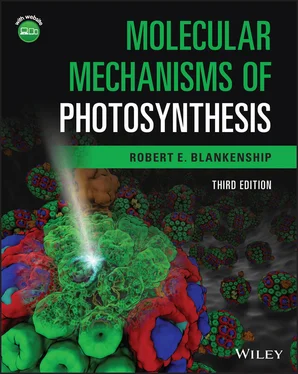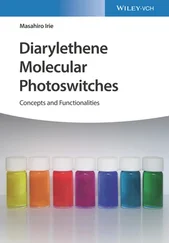1 ...6 7 8 10 11 12 ...28 3 Falkowski, P. and Raven, J. (2007) Aquatic Photosynthesis, 2nd Edn. Princeton, NJ: Princeton Univerity Press.
4 Gómez‐Consarnau, L., Raven, J. A., Levine, N. M., Cutter, L. S., Wang, D., Seegers, B, Arístegui, J., Fuhrman, J. A., Gasol, J. M., and Sañudo‐Wilhelmy, S. A. (2019) Microbial rhodopsins are major contributors to the solar energy captured in the sea. Science Advances 5: eaaw8855.
5 Hohmann‐Marriott, M. F. and Blankenship, R. E. (2011) Evolution of photosynthesis. Annual Review of Plant Biology 62: 515–548.
6 Inoue, K., Tsunoda, S. P., Singh, M., Tomida, S., Hososhima, S., Konno, M., Nakamura, R., Watanabe, H., Bulzu, P.‐A., Banciu, H., Andrei, A.‐S., Uchihashi, T., Ghai, R., Béjà, O., and Kandori, H. (2020) Schizorhodopsins: A family of rhodopsins from Asgard archaea that function as light‐driven inward H+ pumps. Science Advances 6: eaaz2441.
7 Kiang, N., Siefert, J., Govindjee, and Blankenship, R. E. (2007a) Spectral signatures of photosynthesis. I. Review of earth organisms. Astrobiology 7: 222–251.
8 Kiang, N., Segura, A., Tinetti, G., Govindjee, Blankenship, R. E., Cohen, M., Siefert, J., Crisp, D., and Meadows, V. S. (2007b) Spectral signatures of photosynthesis. II. Coevolution with other stars and the atmosphere on extrasolar worlds. Astrobiology 7: 252–274.
9 Kirk, J. T. O. (2011) Light and Photosynthesis in Aquatic Ecosystems, 3rd Edn. Cambridge: Cambridge University Press.
10 Pushkarev, A., Inoue, K., Larom, S., Flores‐Uribe, J., Singh, M., Konno, M., Tomida, S., Ito, S., Nakamura, R., Tsunoda, S. P., Philosof, A., Sharon, I., Yutin, N., Koonin, E. V., Kandori, H., and Béjà, O. (2018) A distinct abundant group of microbial rhodopsins discovered using functional metagenomics. Nature 558: 595–599
11 Schweiterman, E. W., Kiang, N. Y., Parenteau, M. N., Harman, C. E., DasSarma, S., Fisher, T. M., Arney, G. N., Hartnett, H. E., Reinhard, C. T., Olson, S. L., Meadows, V. S., Cockell, C. S., Walker, S. I., Grenfell, J. L., Hegde, S., Rugheimer, S., Hu, R., and Lyons, T. W. (2018) Exoplanet biosignatures: A review of remotely detectable signs of life. Astrobiology 18: 663–708.
12 Thekaekara, M. P. (1973) Extratesrrrestrial solar spectral irradiance. In: A. J. Drummond and M. P. Thekaekara, (eds.) The Extraterrestrial Solar Spectrum. Mount Prospect, IL: Institution of Environmental Sciences, pp. 71–133.
Chapter 2 Photosynthetic organisms and organelles
2.1 Introduction
Green is all around us. The distinctive color of chlorophyll announces the presence of photosynthetic organisms, including trees, shrubs, grasses, mosses, cacti, ferns, and many other types of vegetation. But this is just the tip of the iceberg of photosynthetic life. In addition to these most visible organisms, there is a remarkable variety of microscopic life, including many types of algae and bacteria that carry out photosynthesis. This chapter will introduce the different types of photosynthetic and phototrophic organisms and will give some information about their cellular organization and structure.
All living things on Earth are related to each other. In some cases, the relationships are obviously close, such as between a dog and a coyote, or an orange tree and a lemon tree, while in other cases the relationships are apparent only upon close examination, such as between a bacterium and a human or an amoeba and a fish. To establish these less obvious relationships, it is necessary to look at a deeper level of analysis, down to the cellular and even the molecular levels (Alberts et al ., 2014; Nelson and Cox, 2017). At these levels of organization, the unity of life is readily apparent. All organisms are organized in the same fundamental way, with DNA serving as the master copy of the information needed to construct the organism, RNA as the intermediate working copy, and proteins as the workhorses of the cell, carrying out almost all the chemical reactions that make up metabolism. This basic pattern of information flow and metabolic responsibilities is known as the central dogma of molecular biology. Although some exceptions are known, such as viruses that use RNA for information storage or RNA molecules that act as enzymes, the basic pattern applies to all life. The chemical structures of the building blocks of DNA, RNA, and proteins are exactly the same in bacteria and humans. The process of copying DNA into RNA is called transcription,and the translation of the nucleic acid code into proteins is called translation. This latter process takes place on large protein‐RNA complexes called ribosomes.
Cells are surrounded by membranes, which function as permeability barriers and also carry out many important functions. Membranes are composed of lipids, which are amphipathic molecules with a polar head group and nonpolar tail. The lipids are arranged in a bilayer structure, with the polar head groups toward the outside and inside of the cell, and the nonpolar tails pointed into the center of the bilayer. There are many types of lipids, which form several classes. Two of the most important are phospholipidsand glycolipids. Phospholipids include a phosphate group that is esterified to a glycerol backbone. The most common type of lipids in chloroplasts are glycolipids, in which sugars are found in place of the phosphate groups. The nonpolar tails are long‐chain fatty acids that are esterified to the glycerol groups. They almost always contain one or more double bonds, which increase the fluidity of the membranes of which they are the principal components. The cell membrane is often called the cytoplasmic membrane, while the space enclosed is called the cytoplasm. Additional membranes are found in photosynthetic organisms, in particular the thylakoid membrane, which is the site of photosynthesis in chloroplasts and cyanobacteria.
Membranes also contain proteins, either integral membrane proteins, which span the lipid bilayer, or peripheral membrane proteins, which are associated with one or other side of the membrane but do not cross the bilayer. Many of the proteins essential for photosynthesis are membrane proteins. All cells also contain a variety of carbohydrates, or sugars, as well as many other small molecules essential for proper cellular function. When viewed in this way, the similarities among the various classes of life far outweigh the differences.
Despite the fundamental similarities just pointed out, life nevertheless comes in a remarkable variety of shapes and sizes. These differences form the basis of our mechanisms of classification of living things.
2.2 Classification of life
There are many ways to organize and classify life. No one method is inherently superior to any other, as all such systematic organizations are ultimately only for our benefit. Classification methods are usually structured to accomplish a desired goal, such as rapid identification of organisms in the field or the laboratory. One of the most informative ways to classify organisms is based on evolutionary relationships. This evolutionary, or phylogenetic, approach has led to the recognition that there are three fundamental domains of living organisms: bacteria, archaea(formerly called archaebacteria), and eukarya. This division of the tree of life into the three domains is based on a classification of organisms according to the small subunit rRNA method introduced by Carl Woese ( Fig. 2.1). This method relies on comparisons of the sequences of RNA molecules that are part of the ribosome, the protein‐synthesizing particle. For bacteria and archaea, the RNA molecule that is used is known as 16S rRNA, while for eukaryotes it is a related molecule known as 18S rRNA. The S stands for Svedberg units, which derive from early methods of molecular weight determination using ultracentrifuges. The basis of this molecular evolution method is the fact that the positional order, or sequence, of building blocks of a biological macromolecule retains information about the evolutionary history of the organism. Two organisms that are closely related will have macromolecules (DNA, RNA, or proteins) whose sequences are highly similar, while distantly related organisms will have sequences that have diverged in the long time interval since their common ancestor. The selection of the rRNA molecule as the molecular chronometer is based on the fact that this molecule is universally present in all organisms, has the same function in all organisms, and has an excellent dynamic range. Parts of the molecule change slowly and are therefore useful for establishing distant evolutionary relationships, while other parts change more rapidly and are therefore more useful for fine distinctions among more closely related organisms.
Читать дальше












